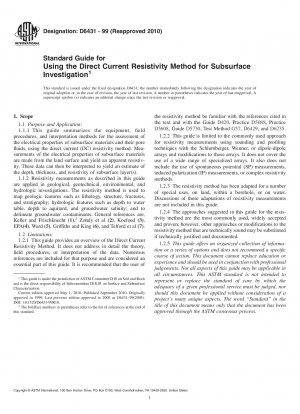ASTM D6431-99(2010)
Standard Guide for Using the Direct Current Resistivity Method for Subsurface Investigation
- Standard No.
- ASTM D6431-99(2010)
- Release Date
- 1999
- Published By
- American Society for Testing and Materials (ASTM)
- Status
- Replace By
- ASTM D6431-18
- Latest
- ASTM D6431-18
- Scope
Concepts8212;The resistivity technique is used to measure the resistivity of subsurface materials. Although the resistivity of materials can be a good indicator of the type of subsurface material present, it is not a unique indicator. While the resistivity method is used to measure the resistivity of earth materials, it is the interpreter who, based on knowledge of local geologic conditions and other data, must interpret resistivity data and arrive at a reasonable geologic and hydrologic interpretation.
Parameter Being Measured and Representative Values:
Table 1 shows some general trends for resistivity values. Fig. 2 shows ranges in resistivity values for subsurface materials.
Materials with either a low effective porosity or that lack conductive pore fluids have a relatively high resistivity (>1000 Ωm). These materials include massive limestones, most unfractured igneous rocks, unsaturated unconsolidated materials, and ice.
Materials that have high porosity with conductive pore fluids or that consist of or contain clays usually have low resistivity. These include clay soil and weathered rock.
Materials whose pore water has low salinity have moderately high resistivity.
The dependence of resistivity on water saturation is not linear. Resistivity increases relatively little as saturation decreases from 100 % to 40-60 % and then increases much more as saturation continues to decrease. An empirical relationship known as Archie''s Law describes the relationship between pore fluid resistivity, porosity, and bulk resistivity (McNeill (8)).
Equipment8212;Geophysical apparatus used for surface resistivity measurement includes a source of power, a means to measure the current, a high impedance voltmeter, electrodes to make contact with the ground, and the necessary cables to connect the electrodes to the power sources and the volt meter (Fig. 1).
While resistivity measurements can be made using common electronic instruments, it is recommended that commercial resistivity instruments specifically designed for the purpose be used for resistivity measurements in the field.
Commonly used equipment includes the following elements:
A source of current consisting of batteries or a generator,
A high-impedance voltmeter or resistivity unit,
Metal stakes for the current and potential electrodes, and
Insulated wire to connect together all of the preceding components.
Care must be taken to ensure good electrical contact of the electrodes with the ground. Electrodes should be driven into the ground until they are in firm contact. If connections between electrodes and the insulated wire are not waterproof, care must be taken to ensure that they will not be shorted out by moisture. Special waterproof cables and connectors are required for wet areas.
A large variety of resistivity systems are available from different manufacturers. Relatively inexpensive battery-powered units are available for shallow surveys. The current source (transmitter) and the potential measurement instrument (receiver) are often assembled into a single, portable unit. In some cases, the transmitter and receiver units are separate. High power units capable of deep survey work are powered by generators. The current used in dc resistivity surveys varies from a few milliamps to several amps, depending on the depth of the investigation.
Signal Enhancement8212;Signal enhancement capability is available in many resistivity systems. It is a significant aid when working in noisy areas or with low power sources. Enhancement is accomplished by adding the res..........
ASTM D6431-99(2010) Referenced Document
- ASTM D420 Standard Guide to Site Characterization for Engineering Design and Construction Purposes
- ASTM D5088 Standard Practice for Decontamination of Field Equipment Used at Nonradioactive Waste Sites*, 2002-01-10 Update
- ASTM D5608 Standard Practice for Decontamination of Field Equipment Used at Low Level Radioactive Waste Sites
- ASTM D5730 Standard Guide for Site Characterization for Environmental Purposes With Emphasis on Soil, Rock, the Vadose Zone and Ground Water
- ASTM D5753 Standard Guide for Planning and Conducting Borehole Geophysical Logging
- ASTM D6235 Standard Practice for Expedited Site Characterization of Vadose Zone and Ground Water Contamination at Hazardous Waste Contaminated Sites
- ASTM D6429 Standard Guide for Selecting Surface Geophysical Methods
- ASTM D653 Standard Terminology Relating to Soil, Rock, and Contained Fluids
- ASTM G57 Standard Test Method for Field Measurement of Soil Resistivity Using the Wenner Four-Electrode Method*, 2001-01-01 Update
ASTM D6431-99(2010) history
- 2018 ASTM D6431-18 Standard Guide for Using the Direct Current Resistivity Method for Subsurface Site Characterization
- 1999 ASTM D6431-99(2010) Standard Guide for Using the Direct Current Resistivity Method for Subsurface Investigation
- 1999 ASTM D6431-99(2005) Standard Guide for Using the Direct Current Resistivity Method for Subsurface Investigation
- 1999 ASTM D6431-99 Standard Guide for Using the Direct Current Resistivity Method for Subsurface Investigation
